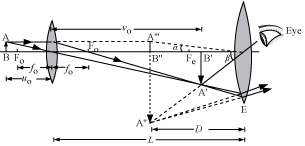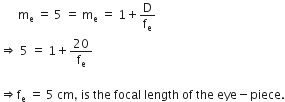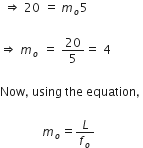(a) Draw a labelled ray diagram showing the formation of a final image by a compound microscope at least distance of distinct vision.
(b) The total magnification produced by a compound microscope is 20. The magnification produced by the eye piece is 5. The microscope is focused on a certain object. The distance between the objective and eyepiece is observed to be 14 cm. If least distance of distinct vision is 20 cm, calculate the focal length of the objective and the eye piece.a) The fig. below shows the formation of image by a compound microscope at least distance of distinct vision.
where, AB = object, A'B' = image formed by objective and A''B'' = image formed by eyepiece.
fo = focal length of objective,
uo = object distance from objective
vo = image distance from objective
D = distance of least distinct vision
L = length of the microscope
(b) Total magnification for least distance of clear vision is given by,
![]() ... (1)
... (1)
where,
L is the separation between the eyepiece and the objective
fo is the focal length of the objective,
fe is the focal length of the eyepiece,
D is the least distance for clear vision,
me is the magnification of the eyepiece,
mo is the magnification of the objective.
Here, m =20, L =14 cm, D = 20 cm, me = 5
Magnification for the eyepiece:
Now, putting the value of mo and me in equation (1), we get![]()

We have,![]() ;is the required focal length of the objective lens.
;is the required focal length of the objective lens.
